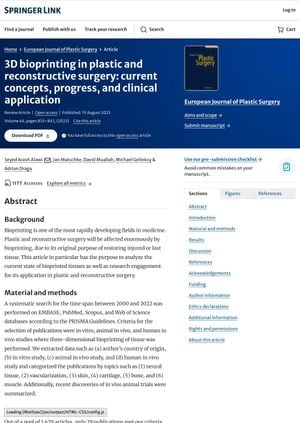3D Bioprinting in Plastic and Reconstructive Surgery: Current Concepts, Progress, and Clinical Application
August 2023
in “
European Journal of Plastic Surgery
”

TLDR 3D bioprinting is advancing in plastic and reconstructive surgery, especially for creating tissues and improving surgical planning, but faces challenges like vascularization and material development.
The document reviews the current state and potential of 3D bioprinting in plastic and reconstructive surgery, with a focus on creating tissues like skin, hair, muscle, cartilage, and bone. It highlights the use of 3D bioprinting in creating skin for burn victims and the integration of 3D imaging technology for precise surgical planning. Notable studies include Yanez et al.'s creation of a bi-layered tissue construct for skin, reducing wound contraction by 17%, and Abaci et al.'s incorporation of human hair follicles into skin constructs, resulting in significant hair growth after 4 weeks. The document also discusses the challenges in bioprinting, such as the need for vascularization and innervation in constructs, and the importance of bioink. It introduces the emerging technology of 4D bioprinting, which allows printed objects to change shape or function over time, with potential applications in dynamic implants and tissue scaffolds. However, it notes that 4D bioprinting is still in early stages and faces challenges such as the development of suitable materials and understanding long-term effects and safety.





